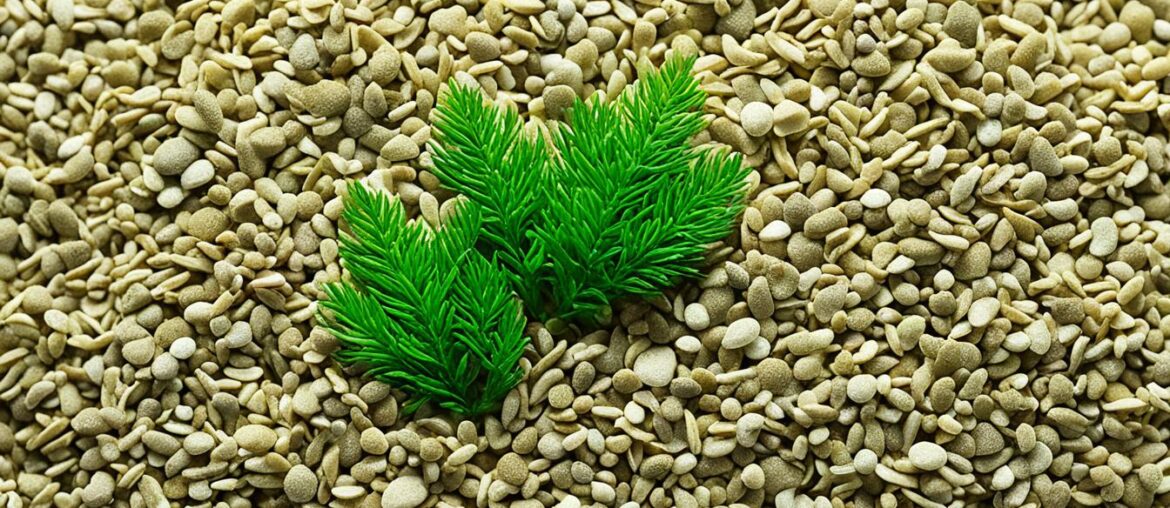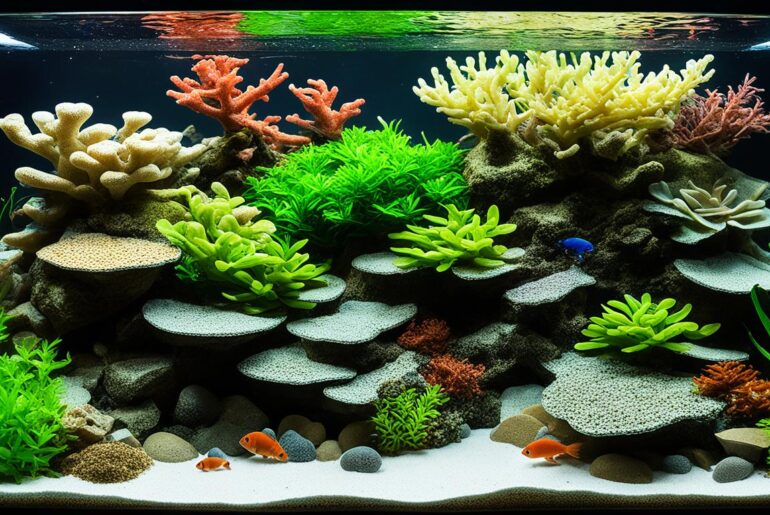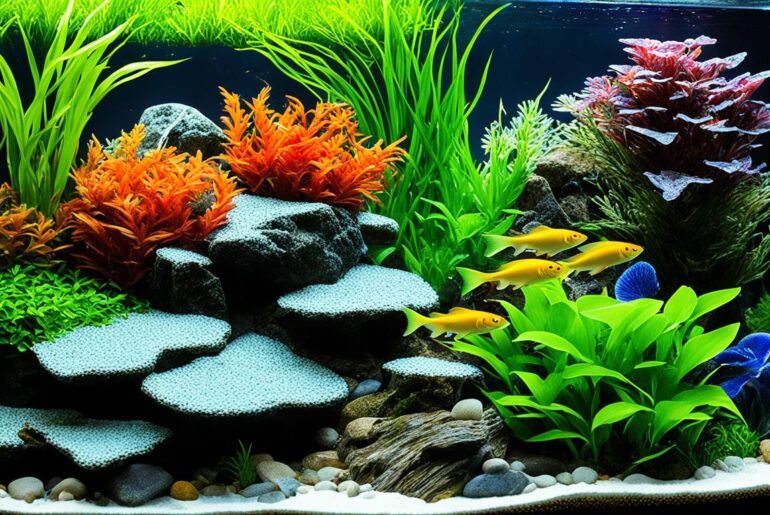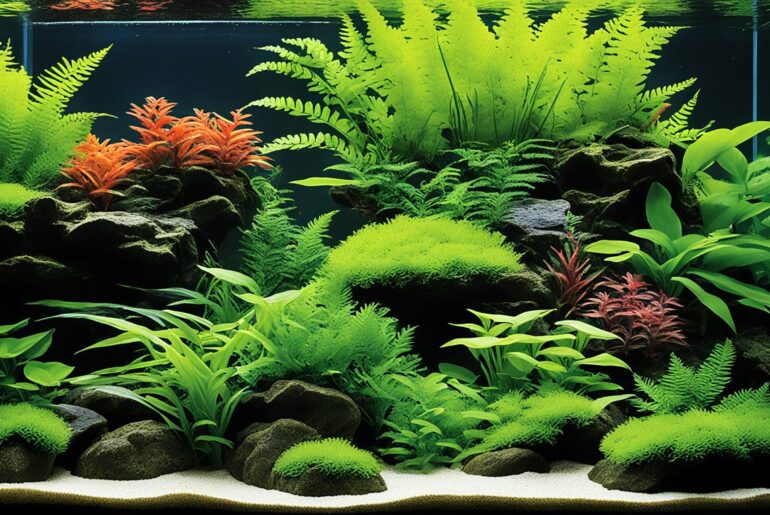When I first started setting up my aquarium, I was faced with countless decisions. From choosing the right fish to selecting the perfect tank, it seemed like every choice played a crucial role in creating a thriving underwater ecosystem. But one decision that really had me stumped was the choice between sand and gravel as the substrate for my aquarium.
As I delved into the world of aquarium substrate, I realized that this seemingly small decision could have a big impact on the overall health and well-being of my aquatic friends. The benefits and drawbacks of sand and gravel became clearer, and I found myself contemplating the best option for my specific needs.
Choosing between sand and gravel goes beyond aesthetics. It’s about creating an environment where both your fish and plants can thrive. In this article, I will guide you through the key differences between sand and gravel, helping you make an informed decision for your aquarium.
Key Takeaways:
- Sand and gravel are the two most common types of freshwater aquarium substrates.
- Sand substrate is cheap, easy to clean, and provides a natural look, but it can create anaerobic dead zones and may not support plants with heavy root growth.
- Gravel is versatile, inexpensive, and better for planted tanks, but it can trap debris and some fish may eat it.
- You can use a combination of sand and gravel for a unique look in your aquarium.
- Consider fish preferences, the presence of planted tanks, cleaning and filtration requirements, substrate replacement, and water chemistry when choosing between sand and gravel.
Pros and Cons of Sand Substrate in Aquariums
When it comes to choosing the right substrate for your aquarium, sand is a popular option that offers several benefits. Let’s take a closer look at the advantages and disadvantages of using sand as a substrate in aquariums.
The Benefits of Sand in Aquariums
One of the main advantages of sand substrate is its affordability and accessibility. You can easily find sand in most fish and pet shops, making it a convenient choice for aquarium enthusiasts.
Another benefit of using sand is that it caters to specific fish and animal preferences. There are different types of sand available, designed to accommodate the needs of burrowing species. These sands provide a satisfactory environment for fish and animals that enjoy digging and creating their own habitat within the aquarium.
Sand substrate is also suitable for rooted aquarium plants with weak root systems. It provides a stable base that helps anchor the plants and allows them to thrive in the aquarium environment.
Furthermore, sand allows for easier waste disposal. Unlike gravel, waste settles on top of the sand, making it simple to clean by using a siphon or gravel vacuum. This feature helps to maintain a cleaner and healthier tank for your aquatic pets.
The Drawbacks of Sand in Aquariums
While sand substrate offers several benefits, there are a few drawbacks to consider as well. One of these drawbacks is the potential messiness associated with sand. Sand particles can easily get sucked into filters, causing clogs and damaging the filtration system if not regularly monitored and cleaned.
Another concern with sand substrate is the possibility of creating anaerobic dead zones. If the sand is not regularly stirred, pockets of anaerobic bacteria can develop, leading to poor water quality and potential harm to fish and plants.
In addition, sand may not be ideal for plants with heavy root growth. Unlike gravel, sand may not provide sufficient anchorage and necessary nutrients for these types of plants. If you’re planning on having plants with extensive root systems, you may need to consider other substrate options.
Lastly, sand substrate may require replacement over time as it can become compacted or worn down. It’s important to monitor the condition of the sand and replace it when necessary to ensure the overall health of your aquarium.
In summary, sand substrate offers affordability, accessibility, and benefits for burrowing species and rooted aquarium plants. However, it can be messy, prone to creating anaerobic dead zones, and may not support heavy root growth. Consider these pros and cons when deciding if sand is the right choice for your aquarium setup.
Expert Tip:
“To prevent sand from getting sucked into filters, consider using a pre-filter or sponge over the intake to protect your filtration system.” – Dr. Aquarium
Pros and Cons of Gravel Substrate in Aquariums
Gravel substrate is a popular and versatile choice for aquariums, offering various colors, shapes, and sizes to suit different preferences. It is widely available and inexpensive, making it easily accessible for aquarium enthusiasts. One of the significant advantages of gravel is its compatibility with planted tanks. Gravel provides a stable base for plants and allows for root growth, promoting healthier and robust foliage. Additionally, gravel is inert and does not affect the water chemistry of the aquarium, ensuring a stable environment for your aquatic pets.
Gravel also works well with most filtration systems, allowing efficient water flow and maintaining water quality. However, it is crucial to address a few potential drawbacks of using gravel as a substrate. One consideration is that gravel can trap debris, leading to the accumulation of waste and harmful substances. To prevent this, regular cleaning with a gravel vacuum is necessary to ensure a clean and healthy tank environment.
Another concern is the possibility of fish ingesting gravel, which can cause health issues. Some fish species have a tendency to nibble on gravel, mistaking it for food. To prevent this, it is advisable to choose larger gravel sizes that are less likely to be swallowed by fish. Additionally, rough gravel can pose a risk to fish that enjoy burrowing or digging in the substrate. It is essential to select smooth gravel to avoid any injuries or discomfort to your aquatic pets.
Despite these considerations, gravel substrate remains a popular choice for aquarium enthusiasts due to its aesthetic appeal, plant-friendliness, and compatibility with filtration systems. By ensuring proper cleaning and selecting appropriate gravel sizes, you can create a visually appealing and healthy environment for both your fish and plants.
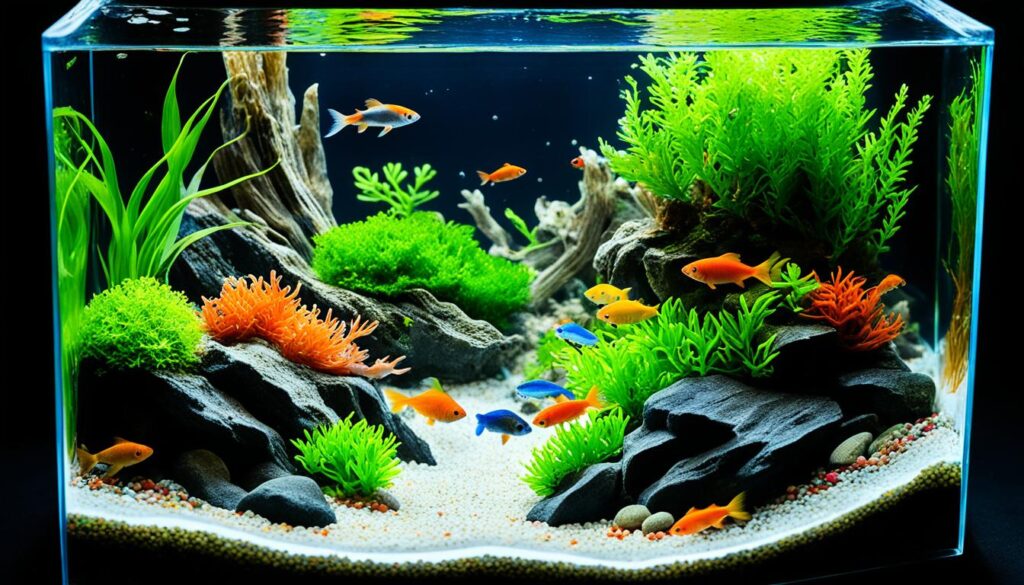
Gravel substrate in aquariums offers a stable base for plants, allowing root growth and promoting healthier foliage.
With that being said, let’s take a closer look at the pros and cons of using sand substrate in aquariums in the next section.
Using Sand and Gravel Together
When it comes to creating an aesthetically pleasing aquarium, using sand and gravel together can provide a unique and visually appealing look. By incorporating both substrates, you can create contrasting textures, colors, and distinct areas within your tank for specific plants or fish preferences.
Sand can serve as the base layer, offering a natural appearance while also allowing for fish to burrow and explore. Its fine texture provides a smooth surface that is gentle on fish fins and promotes a more natural environment. Additionally, sand can be an ideal substrate for certain species that originate from sandy habitats.
The gravel, on the other hand, can be added on top of the sand layer to create a contrasting texture and color. With gravel, you can choose from various shapes, sizes, and colors to suit your desired aesthetic. Gravel also provides better stability for planted tanks, offering a supportive base for rooted plants to thrive.
By using a mixed substrate of sand and gravel, you can create different areas within your aquarium to accommodate the specific needs of your aquatic life. For example, you can create a sandy area for burrowing fish or a gravel area for plants with heavier root growth. This flexibility allows for a customized and dynamic aquatic environment.
Considerations for Using a Mixed Substrate
While using sand and gravel together can result in a visually appealing aquarium, it’s important to consider the specific needs of your plants and fish. Some factors to consider include:
- The type of plants you have: Some plants may require specific substrate conditions, such as nutrient-rich soil or deeper penetration for root growth.
- The preferences of your fish species: Certain species may have specific substrate preferences, such as burrowing or sand-sifting behavior. Ensure that the substrate combination supports their natural instincts and behaviors.
- The overall balance of the tank: It’s crucial to strike the right balance between sand and gravel to maintain the stability and aesthetic appeal of the tank. Experiment with different ratios and arrangements to find the perfect combination for your aquarium.
By considering these factors, you can create a harmonious environment that supports the health and wellbeing of your aquatic life while providing a captivating visual display.
Comparison of Sand and Gravel in Aquariums
| Factors | Sand | Gravel |
|---|---|---|
| Texture | Smooth and fine | Varies based on type |
| Plant Compatibility | May not support heavy root growth | Provides a stable base for rooted plants |
| Cleaning and Maintenance | Easy to clean but prone to mess | Requires thorough cleaning with a gravel vacuum |
| Fish Behavior | Allows for burrowing and sand-sifting behavior | Suitable for bottom-dwelling fish |
| Aesthetics | Natural and soft appearance | Variety of colors, shapes, and sizes |
Choosing the Best Substrate for Your Fish and Plants
When it comes to creating the perfect environment for your aquarium, choosing the right substrate is crucial. The substrate not only provides a foundation for your fish and plants but also plays a vital role in maintaining water quality and aesthetics. But with so many options available, how do you choose the best substrate for your fish and plants?
Consider the specific needs and preferences of your aquatic inhabitants. If you have fish that enjoy burrowing or require a soft substrate, sand may be the better option. Sand provides a natural and comfortable environment for burrowing species, allowing them to exhibit their natural behavior.
On the other hand, if you have a planted tank or need a substrate that offers better filtration, gravel may be more suitable. Gravel provides a stable base for rooted plants and allows for better water flow, promoting the growth of beneficial bacteria. It also prevents the accumulation of detritus, keeping your tank clean and healthy.
It is important to consider the maintenance and cleaning requirements of each substrate as well. Sand is easier to clean as waste tends to settle on top, making it readily removable with a siphon or gravel vacuum. On the other hand, gravel may require more thorough cleaning with the help of a gravel vacuum to prevent debris from getting trapped between the rocks.
Furthermore, consider the potential impact on water chemistry. Both sand and gravel neutralize pH to some extent, but sand has a minimal effect on water chemistry. If you have delicate or sensitive fish that require precise water parameters, gravel may be the better option.
To help you visualize the differences between sand and gravel, here is a comparison table:
| Criteria | Sand | Gravel |
|---|---|---|
| Filtration | Minimal | Improved water flow and bacterial growth |
| Plant Growth | Limited support for heavy root growth | Provides a stable base for rooted plants |
| Maintenance | Easy to clean, waste sits on top | Requires thorough cleaning with a gravel vacuum |
| Water Chemistry | Minimal impact | Neutralizes pH to some extent |
| Aesthetics | Natural and fine-grained | Versatile, comes in various colors and sizes |
Remember, the best substrate choice ultimately depends on the specific requirements of your fish and plants and the aesthetic look you want to achieve. Take the time to research and consider all factors before making your decision. Happy aquascaping!
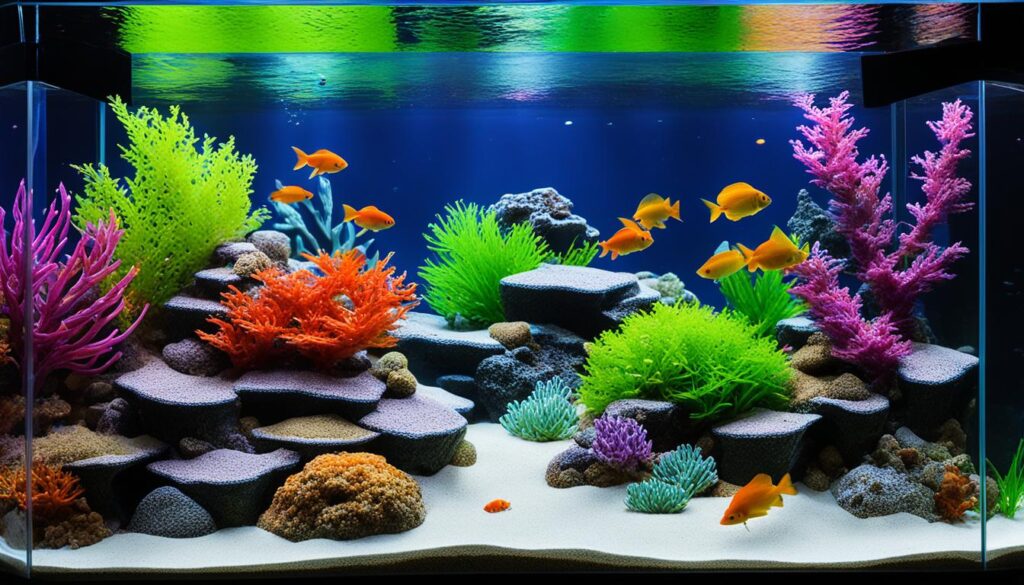
Tips for Using Sand in Aquariums
When it comes to using sand in aquariums, there are a few tips that can help you create a successful and visually appealing setup. Here are some key pointers to keep in mind:
- Choose aquarium-specific sand: It’s important to select sand that is specifically designed for aquarium use. This ensures that it is safe for your fish and won’t alter the water chemistry.
- Consider the needs of your fish and plants: Different fish species and plants have varying preferences when it comes to substrate. Some fish and animals, like cichlids or hermit crabs, enjoy burrowing, so look for sand that allows for this behavior.
- Enriched sand for rooted plants: If you have aquarium plants with heavy root growth, consider using sand that is enriched with nutrients. This will provide them with the essential elements they need to thrive.
- Be cautious when cleaning: When cleaning your aquarium, be careful not to stir up the sand too much. Excessive disturbance can create cloudiness and make it difficult for your filters to function effectively.
- Consult your local fish or pet store: If you’re unsure about which sand to choose, it’s always a good idea to seek advice from professionals. They can recommend suitable options based on your specific requirements.
By following these tips, you can ensure that your sand substrate provides a safe and comfortable environment for your aquatic pets. Just remember to choose the right sand, consider the needs of your fish and plants, and clean it gently to maintain a healthy and beautiful aquarium.
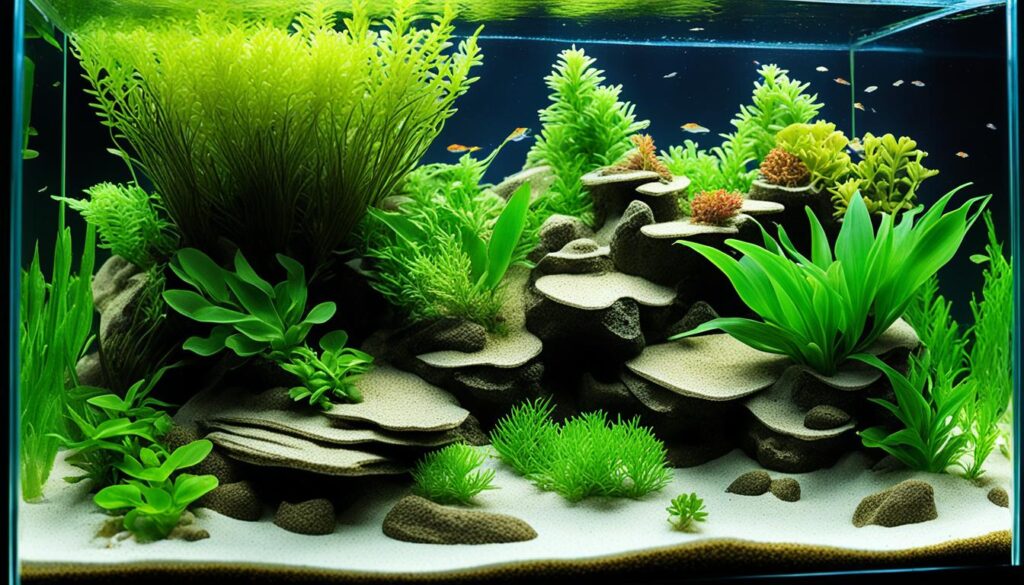
“Choosing the right sand for your aquarium is crucial to the well-being of your fish and plants. By considering their preferences and needs, you can create a thriving underwater ecosystem.” – [Your Name]
Tips for Using Gravel in Aquariums
When it comes to using gravel in aquariums, there are a few key tips to keep in mind to ensure a successful and thriving aquatic environment. Whether you’re a beginner or an experienced aquarist, these recommendations will help you make the most of gravel as a substrate choice.
1. Choose the Right Gravel
Selecting the appropriate gravel for your aquarium is crucial. Consider the specific needs of your fish and plants, as well as the overall aesthetic you want to achieve. It’s generally recommended to use smooth, round gravel to prevent any harm to bottom-feeding fish and delicate plant roots.
2. Thoroughly Clean the Gravel
Regular cleaning is essential to maintain water quality in your aquarium. Use a gravel vacuum to remove debris and trapped waste from the substrate. By vacuuming the gravel regularly, you can prevent the accumulation of harmful substances and ensure a clean and healthy habitat for your aquatic pets.
3. Consider Gravel as a Cap
If you’re planning to create a planted tank, consider using gravel as a cap for nutrient-rich soil. This technique promotes optimal plant growth by providing a stable base while allowing the roots to access the essential nutrients in the substrate.
4. Consult with Experts
For specific recommendations on suitable aquarium gravel options, it’s always a good idea to consult with your local fish or pet store. They can provide expert advice based on your unique setup and the particular requirements of your fish and plants.
By following these tips, you can make the most of gravel as a substrate in your aquarium. Remember to choose the right gravel, clean it regularly, consider it as a cap for planted tanks, and seek guidance when needed. Your fish and plants will thrive, and you’ll create a visually appealing and balanced aquatic environment.
| Benefits | Considerations |
|---|---|
| Provides a natural look | May trap debris |
| Allows for rooted aquarium plants | Potential risk of fish eating gravel |
| Offers versatility in colors, shapes, and sizes | Need for thorough cleaning |
| Suitable for most filtration systems | Not ideal for heavy root growth in plants |
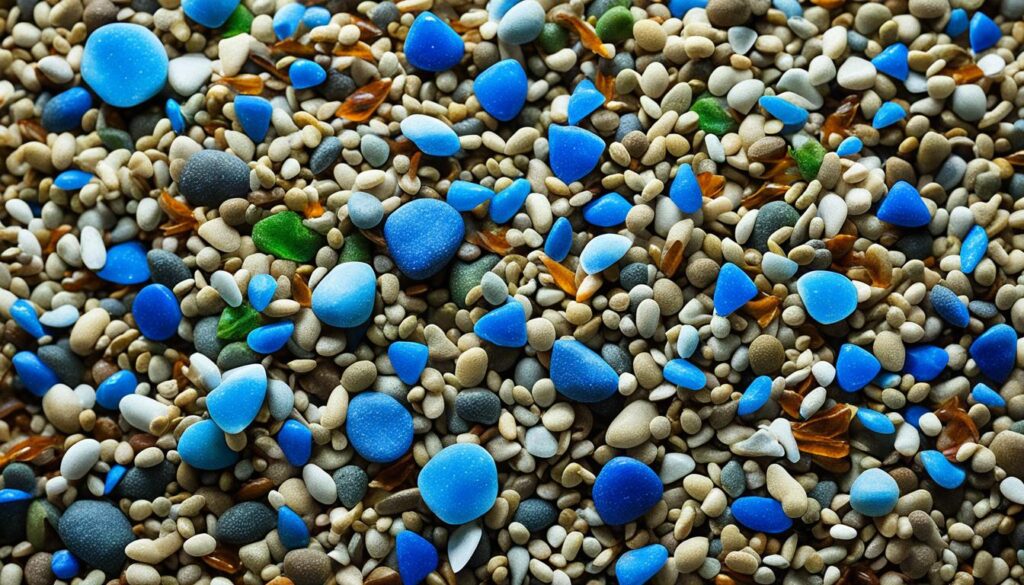
Maintaining and Cleaning Sand Substrate
Maintaining and cleaning sand substrate in aquariums requires some special considerations. Since waste sits on top of the sand, it is relatively easy to clean by using a siphon or gravel vacuum to remove debris.
However, it is important to be cautious when cleaning to avoid stirring up the sand and potentially damaging filters. Sand can also get sucked into the siphon or filter, so extra care is needed during cleaning.
Regular monitoring for the development of anaerobic dead zones is crucial. These zones occur when sand becomes compacted and devoid of oxygen, leading to potential harm to fish and plants. To prevent anaerobic dead zones, it is essential to regularly stir the sand using a gentle method, such as using a clean stick or aquarium-safe tool to lightly agitate the surface.
Here are some tips for maintaining and cleaning sand substrate in aquariums:
- Use a siphon or gravel vacuum to remove debris on the surface of the sand.
- Be cautious when cleaning to avoid stirring up the sand and potentially damaging filters.
- Regularly monitor for the development of anaerobic dead zones and stir the sand to prevent them.
By following these tips, you can maintain a clean and healthy sand substrate in your aquarium while ensuring the well-being of your fish and plants.
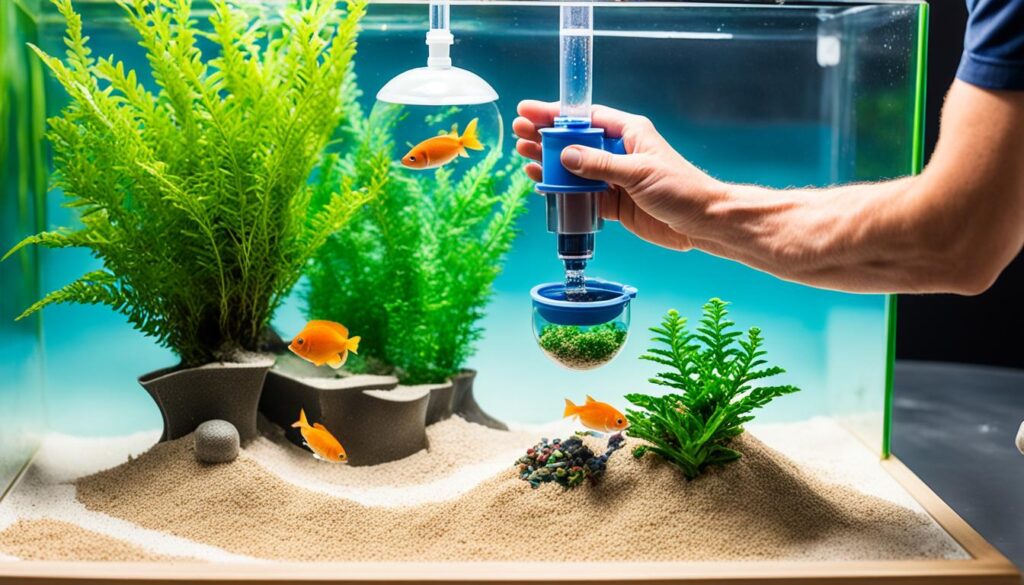
| Pros of Maintaining Sand Substrate | Cons of Maintaining Sand Substrate |
|---|---|
| Sand substrate provides a natural look for the aquarium. | Sand can create anaerobic dead zones if not regularly stirred. |
| Sand allows fish to burrow. | Sand may not support plants with heavy root growth. |
| Sand can make waste disposal easier by allowing waste to settle on top. | Sand can get sucked into siphons or filters during cleaning. |
Maintaining and Cleaning Gravel Substrate
Maintaining and cleaning gravel substrate in aquariums is essential for maintaining water quality and ensuring a healthy environment for your aquatic inhabitants. Regular cleaning helps remove debris, waste, and other impurities that can accumulate between the rocks. Here are some tips to keep your gravel substrate clean and well-maintained:
Regular Vacuuming
Using a gravel vacuum is an effective way to clean your gravel substrate. This tool allows you to remove debris and waste that can get trapped between the rocks. Simply siphon the gravel vacuum through the gravel, being careful not to disturb the substrate too much. Regular vacuuming, especially during water changes, helps prevent waste build-up and keeps the aquarium clean.
Water Changes
Regular water changes are crucial for maintaining water quality in your aquarium. During water changes, take the opportunity to vacuum the gravel substrate. This helps remove any accumulated waste and ensures fresh, clean water for your fish. Aim to perform partial water changes every 1-2 weeks, depending on the specific needs of your aquarium.
Beneficial Bacteria
Gravel provides a large surface area for beneficial bacteria to grow. These bacteria play a crucial role in the nitrogen cycle, converting toxic ammonia into less harmful compounds. By maintaining a healthy population of beneficial bacteria in your gravel substrate, you promote effective filtration and maintain stable water parameters. Avoid disturbing the gravel excessively during cleaning to preserve the beneficial bacteria colonies.
Preventing Waste Build-Up
To prevent waste build-up and potential water quality issues, it’s important to practice good aquarium maintenance habits. Avoid overfeeding your fish, as excess food can contribute to waste and debris in the gravel. Remove any uneaten food promptly to prevent it from decaying and causing water quality problems. Additionally, consider adding a gravel-sifting fish species, such as Corydoras catfish, to help keep the substrate clean by consuming leftover food and debris.
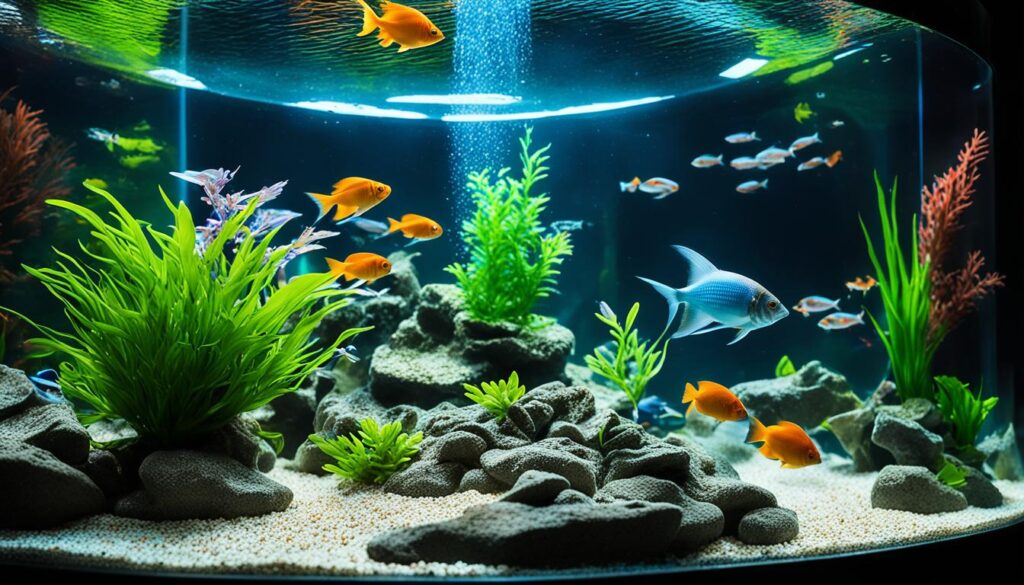
Comparison Between Sand and Gravel Substrates
| Factors | Sand Substrate | Gravel Substrate |
|---|---|---|
| Cost | Low | Low |
| Cleaning | Easy with a siphon or gravel vacuum | Requires thorough cleaning with a gravel vacuum |
| Plant Support | Not suitable for plants with heavy root growth | Provides a stable base for rooted plants |
| Aesthetic | Natural, beach-like appearance | Various colors, shapes, and sizes |
| Filtration | Sand can get sucked into filters | Does not affect filtration systems |
| Debris Trapping | Less likely to trap debris | Requires thorough cleaning with a gravel vacuum |
| Burrowing Fish | Allows fish to burrow | May cause injury to burrowing fish |
By diligently maintaining and cleaning your gravel substrate, you can ensure a clean and healthy aquarium environment for your fish and plants. Regular vacuuming and water changes, along with proper waste management, will help maintain water quality and promote the well-being of your aquatic pets.
Factors to Consider When Choosing Between Sand and Gravel
When deciding between sand and gravel for your aquarium substrate, it’s important to consider several factors that will affect the overall health and well-being of your aquatic environment. These factors include fish preferences, the presence of a planted tank, cleaning and filtration requirements, substrate replacement, and water chemistry.
Fish Preferences:
Fish have different preferences when it comes to substrate. Burrowing fish, such as cichlids and loaches, may prefer sand as it allows them to create their own hiding spots and shelters. On the other hand, fish that don’t burrow, like tetras and guppies, may be better suited for gravel.
Planted Tank:
If you have a planted tank, the type of substrate you choose can impact the growth and health of your plants. Gravel provides a stable base for plants with heavier root systems and ensures proper nutrient circulation. Sand, on the other hand, may be more suitable for plants with delicate roots or those that require nutrient-rich substrates.
Cleaning and Filtration:
Consider your cleaning and filtration routine when deciding between sand and gravel. Sand is easier to clean as waste sits on top and can be easily siphoned out, while gravel may require more thorough cleaning with a gravel vacuum to remove debris trapped between the rocks. It’s important to note that sand can get sucked into filters, potentially causing damage.
Substrate Replacement:
Another factor to consider is the longevity of your chosen substrate. Sand may need to be replaced over time as it can become compacted or develop anaerobic dead zones if not regularly stirred. Gravel, on the other hand, has a longer lifespan and may not require frequent replacement.
Water Chemistry:
Both sand and gravel are suitable for aquariums as long as they do not impact water chemistry in a negative way. It’s important to choose substrates that will not alter the pH, hardness, or any other parameters of your tank’s water. Consider testing your water and selecting a substrate that is compatible with your desired water conditions.
Sand vs. Gravel Comparison
| Factors | Sand | Gravel |
|---|---|---|
| Fish Preferences | Prefers burrowing fish | Prefers non-burrowing fish |
| Planted Tank | Suitable for delicate rooted plants | Suitable for plants with heavier root systems |
| Cleaning and Filtration | Easier to clean, potential filter damage | May require thorough cleaning with a gravel vacuum |
| Substrate Replacement | May require regular replacement | Longer lifespan, less frequent replacement |
| Water Chemistry | No significant impact | No significant impact |
Considering these factors will help you make an informed decision when choosing between sand and gravel for your aquarium substrate. Remember to prioritize the needs of your fish and plants, as well as your own maintenance preferences, to create a thriving aquatic environment.
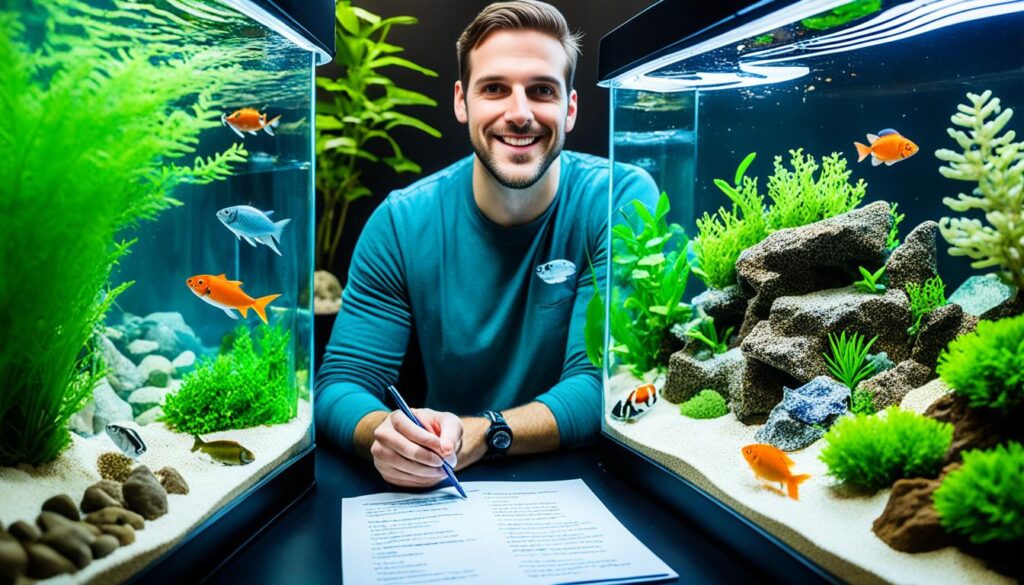
Conclusion
In conclusion, when choosing between sand and gravel as the substrate for your aquarium, it’s important to consider the specific needs and preferences of your fish and plants. Both options have their advantages and disadvantages, so it’s essential to weigh the factors that are most important to you and your aquatic setup.
If you have fish that enjoy burrowing or require a soft substrate, sand may be the better choice. It provides a natural look and can be beneficial for rooted aquarium plants. However, sand can create mess and potentially cause filter damage if not cleaned and stirred regularly.
On the other hand, gravel is versatile, inexpensive, and better suited for planted tanks as it allows for stable root growth. It can work well with most filtration systems and is easy to clean with a gravel vacuum. However, gravel can trap debris and may need frequent cleaning to maintain water quality.
Ultimately, the decision between sand and gravel will depend on various factors such as fish preferences, the presence of a planted tank, cleaning and filtration requirements, substrate replacement needs, and water chemistry considerations. By carefully evaluating these factors, you can make an informed decision and choose the substrate that will best meet the needs of your fish and plants, providing a healthy and aesthetically pleasing aquarium environment.
FAQ
What are the key differences when comparing sand vs gravel in aquariums?
The key differences include factors such as cost, ease of cleaning, natural look, suitability for fish and plants, and impact on water chemistry.
What are the pros and cons of sand substrate in aquariums?
The benefits of sand substrate include its affordability, natural appearance, and suitability for burrowing fish and rooted plants. However, sand can create anaerobic dead zones and may not support heavy-rooted plants.
What are the pros and cons of gravel substrate in aquariums?
The advantages of gravel substrate include its versatility, affordability, stability, and compatibility with most filtration systems. However, gravel can trap debris and may be harmful if ingested by certain fish.
Can I use sand and gravel together in an aquarium?
Yes, using a combination of sand and gravel in aquariums can create a unique look and provide different areas for specific plants or fish preferences.
How do I choose the best substrate for my fish and plants?
Consider factors such as fish preferences, the presence of a planted tank, cleaning and filtration requirements, substrate replacement needs, and water chemistry to choose the best substrate for your aquarium.
What tips should I keep in mind when using sand in aquariums?
Choose sand specifically designed for aquariums, consider the needs of your fish and plants, be cautious during cleaning to avoid damaging filters, and check with your local fish or pet store for recommendations.
What tips should I keep in mind when using gravel in aquariums?
Choose gravel suitable for your fish and plants, clean it with a gravel vacuum, consider using it as a cap for nutrient-rich soil, and consult your local fish or pet store for suitable options.
How do I maintain and clean sand substrate in aquariums?
Use a siphon or gravel vacuum to remove debris, be cautious not to stir up the sand or damage filters, and regularly stir the sand to prevent the development of anaerobic dead zones.
How do I maintain and clean gravel substrate in aquariums?
Thoroughly clean gravel with a gravel vacuum to remove trapped debris, perform regular water changes, and ensure diligent cleaning to prevent waste buildup and maintain water quality.
What factors should I consider when choosing between sand and gravel?
Consider fish preferences, the presence of a planted tank, cleaning and filtration requirements, substrate replacement needs, and water chemistry to make an informed decision between sand and gravel.
What are the final thoughts on choosing between sand and gravel in aquariums?
The final decision should be based on the specific needs and preferences of your fish and plants, considering factors such as burrowing habits, rooted plant requirements, cleaning and filtration needs, and water chemistry impact.
